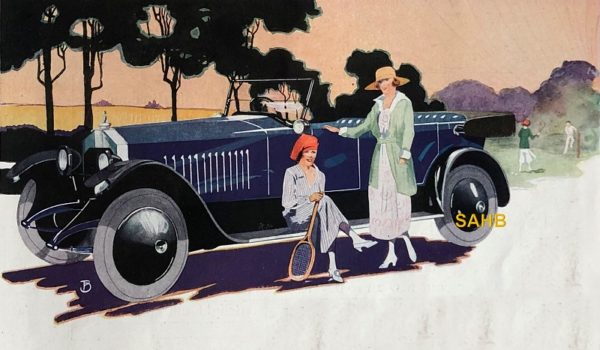
This very English illustration is of a very American motor car. It was used by the distributors, H.C. Motor Company Limited of Great Portland Street, London W.1, to promote two versions of the car, Models 48 (40 h.p.) and 34 (23 h.p.). The only visual difference was apparently the loss of 3 inches in wheelbase for the Model 34.
In 1860 Stephen Velie married John Deere’s daughter. Their three sons all worked for John Deere. In 1902 the youngest, Willard Lamb Velie, formed his own firm in Moline, Illinois, the Velie Carriage Company, soon to be the largest in the Middle West. In 1908, he formed the Velie Motor Vehicle Co., and laid down a batch of 1,000 chassis for 1909. They had 30/35hp 4-cylinder engines made by the American & British Manufacturing Co. in Bridgeport, Connecticut, and Brown-Lipe gearboxes.
At a competitive $1,750 for tourer or roadster they sold well, no doubt helped by the use of John Deere dealerships; up to 1915, the cars were listed in John Deere catalogues. The first Velie Six arrived in 1914 with a 34hp Continental engine. The cars were so popular in Louisiana that a small community north of Shreveport named itself Velie; it still survives. In 1920 production reached a peak of 7,738, and continued at 4000 or more throughout the 1920s.
The Models 48 and 34 used Continental or Falls engines, until in 1922 the company built its own. Velie dabbled with an eight-cylinder Lycoming to accompany its sixes from 1928, at which time the company was close to failure. Willard Velie died in 1928 and his son Willard Junior died a year later, at which time the company went under; it would probably not have survived the Depression in any case. The factory reverted to John Deere and Willard Velie’s magnificent 46-room mansion later became a high-class restaurant.
In 1927, the company bought out a general aviation company, moving it to Iowa as Mono Aircraft Inc., and began producing aircraft. The Monocoupe 70 was said to be “an instant success”. They also provided engines for aircraft: Velie’s M-5 aircraft engine from 1928 put out 65 hp and its production, and development of the aircraft line, survived the demise of Velie by a number of years.
The advertisement from which this illustration is taken was typical of those placed by small English distributors hoping to attract dealers. A rather plaintive phrase was included: “Enquiries from responsible agents able to handle this car are invited.” The use of an illustration allowed depiction of English style and right-hand drive, but it is possible that very few if any RHD cars were sold.
Photo courtesy of The Richard Roberts Archive.







Leave a Comment